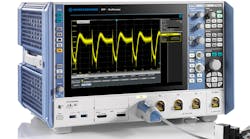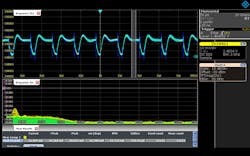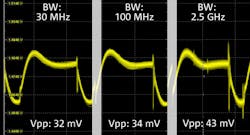For power-integrity tests, users rely on oscilloscopes. However, with more precise requirements, measurement errors that approach the required measurement value are problematic. Every millivolt of measurement error is critical; for example, when measuring a 1.5-V power rail with 2% tolerance. In addition, high-speed digital signals and other sources can couple onto power rails, requiring gigahertz of bandwidth to identify. Below are seven tips on how to quickly and accurately characterize rail noise and identify coupled signals.
1. Start with a low-noise oscilloscope.
Measurements will never be better than the noise of the measurement system. Every oscilloscope contributes internal broadband noise to measurements. Choosing a scope that has lower noise ensures a better measurement (Fig. 1). For example, if you’re trying to measure a 1.8-V rail with 2 % tolerance, having 10 mV of scope and probe noise is problematic, since this will be additive to the signal you’re measuring.
1. Low-noise, high-bandwidth scopes like the 8-GHz R&S RTP enable fast and accurate characterization of dc rails. Specialized probes designed specifically for power-rail measurements, such as the 4-GHz R&S RT-ZPR40 power-rail probe, have a number of attributes to produce high-accuracy measurements. (Source: Rohde & Schwarz)
Oscilloscope manufacturers characterize and publish ac rms noise at each vertical attenuation setting, and this generally is a good first step in choosing a low-noise scope. For power integrity, though, the worst-case peak-to-peak voltage matters. It’s easy to check this value with the scope you’re using. With no inputs connected, measure the peak-to-peak amplitude at the vertical setting you will be using.
Many newer scopes offer 10- and 12-bit vertical resolution. However, the additional resolution is almost always obscured by noise unless averaging or high-resolution mode is used. For oscilloscopes on the market today, front-end noise hasn’t caught up with advances in vertical resolution. Noise is a better indication of measurement accuracy than bits of resolution.
2. Use the 50-Ω path.
Many oscilloscopes offer 50-Ω and 1-MΩ paths. The 50-Ω path generally has lower noise. In addition, if using an active probe for power-integrity measurements, the probe will use the 50-Ω path. Measuring peak-to-peak noise of the oscilloscope with the probe you’re using on the 50-Ω path will indicate how much measurement error you will have.
3. Use the most sensitive vertical setting possible.
Oscilloscope noise is a function of vertical attenuation settings. Smaller settings have less noise than larger settings. Most oscilloscopes don’t have sufficient offset to use large vertical gain. For example, at 10 mV per division, the oscilloscope may only offer 120 mV of internal offset. This forces users to choose a lower vertical setting to get the signal on the display, and therefore will result in a less accurate measurement.
There are other ways to compensate for limited internal offset. A blocking capacitor removes dc offset, which solves the problem of insufficient offset. But, it eliminates the ability to see low-frequency drift that can occur when subsystems turn on and off. The ac coupling on scopes also provides dc blocking. However, ac coupling has the same limitation of eliminating the ability to see low-frequency drift, and for many scopes is limited to the 1-MΩ path.
4. Use a high-bandwidth scope and limit the bandwidth to reduce measurement noise.
Higher-bandwidth scopes are becoming increasingly useful, since they allow teams to see coupled signals such as high-speed clocks riding on the power rail. Because scope and probe noise has linear noise density over broadband frequencies, using maximum bandwidth will result in over-reporting power-rail noise values.
In the absence of high-frequency coupled signals, limit oscilloscope bandwidth to reduce broadband noise. This technique significantly increases measurement accuracy. A common question is “How much should you reduce measurement bandwidth?”
2. Using an FFT and a high-bandwidth solution, such as the RTP oscilloscope and RT-ZPR40 power-rail probe, enables teams to quickly determine both coupled sources and the degree to which they can limit bandwidth while retaining signal content. (Source: Rohde & Schwarz)
Experienced users often view the fast Fourier transform (FFT) to determine how much bandwidth reduction is possible while still capturing periodic and random disturbances on the power rail (Fig. 2). When viewing the FFT, bandwidth can be reduced to the point where no higher-frequency tones are present. Another method is simply to look at the signal. If the signal shape changes at all when you reduce bandwidth, you’ve reduced the bandwidth too much (Fig. 3).
3. Peak-to-peak voltage measurements using an RTP oscilloscope and RT-ZPR40 power-rail probe show the impact of bandwidth-limiting at three different values. The 2.5-GHz bandwidth setting visually shows coupled signals that are attenuated and ultimately missed with lower-bandwidth limit settings. (Source: Rohde & Schwarz)
5. Use a power-rail probe.
Most oscilloscope manufacturers offer specialized probes crafted for power-rail measurements. They include a number of capabilities not found in other probes. Large built-in offset compensates for lack of built-in oscilloscope offset. This enables users to choose the lowest vertical attenuation setting for reduced noise. Power-rail probes typically have 1:1 attenuation ratios, meaning they will produce significantly less noise than probes with 10:1 attenuation ratio. Power-rail probes have high dc impedance, typically 50 kΩ, which is significant, since rail impedances are typically in the milliohm range.
Power-rail probes come with a variety of connection methods, including a 50-Ω pigtail coax for the highest-quality measurements, as well as a probe browser where flexibility is paramount. Use of an SMA pigtail connector requires some forethought, since they work best when designed in. Browsers are more flexible, but don’t have the accuracy of SMA pigtails.
Power-rail probes should have sufficient bandwidth to capture coupled signals. Users can achieve a low-noise probe with a passive probe that has 1:1 attenuation ratio. However, the probes have bandwidth limits of less than 40 MHz. While this approach is good, since it uses the higher-impedance 1-MΩ path, bandwidth-limiting inherent to the probe eliminates critical signal content and will under-report peak-to-peak voltage measurements. Some manufacturers specify guaranteed power-rail probe bandwidth, while others provide the typical value. For example, the R&S RT-ZPR40 power-rail probe has a typical 3-dB rolloff of 4 GHz.
Check with your oscilloscope vendor to determine which scope models are supported with their power-integrity probes. For some companies, the probes will work across all models that have a probe interface, while for other companies, the probe may only work on a subset of models. Worse, insertion of the probe in unsupported models may run the risk of damaging the scope’s inputs.
6. Use high dc impedance.
Getting accurate dc values requires low measurement loading. If you connect the scope’s 50-Ω path directly to a power rail, the 50-Ω loading will change the dc level of the rail. To mitigate this effect, higher measurement impedance is required. The 1-MΩ oscilloscope path has a sufficiently high impedance level at dc, but unfortunately there’s more noise and it isn’t the path supported with power-rail probes. Power-rail probes typically have dc impedance of 50 kΩ, greater than a million times more impedance than the rail itself. This means that the dc rail voltage will be only very minimally impacted during measurement.
7. Choose a scope with fast update rate.
Even the fastest digital oscilloscopes are blind more than 90% of the time. Between each acquisition, the scope must process the waveform before acquiring the next waveform. Infrequent events—in the case of power rails, this means potential worst-case peak-to-peak voltages—can be missed. To compensate, users turn on infinite persistence, automated measurements, and wait until the highest amplitudes are found.
How long should a user wait? It depends on the target system. Scopes with a fast update rate will show the overall noise envelope faster, and users will see a better graphical view of the dc rail signal behavior. For an oscilloscope that updates 1000 waveforms per second with automated measurements, users will achieve measurement results 20 times faster than an oscilloscope that updates 50 waveforms per second with automated measurements enabled.
Instead of waiting for measurement values to converge over 20 minutes with the slower scope, a user of the faster scope can accomplish the same task in just one minute. Since systems incorporate an ever-larger number of power rails, each of which requires verification, the scope update rate is becoming more and more important.
Power integrity continues to grow in significance as FPGAs, ASICs, and standard device rails become smaller and tolerances become tighter. Choosing the right measurement tools enables fast and accurate characterization of each rail.
Joel Woodward is Strategic Oscilloscope Planner at Rohde & Schwarz in Munich, Germany.





